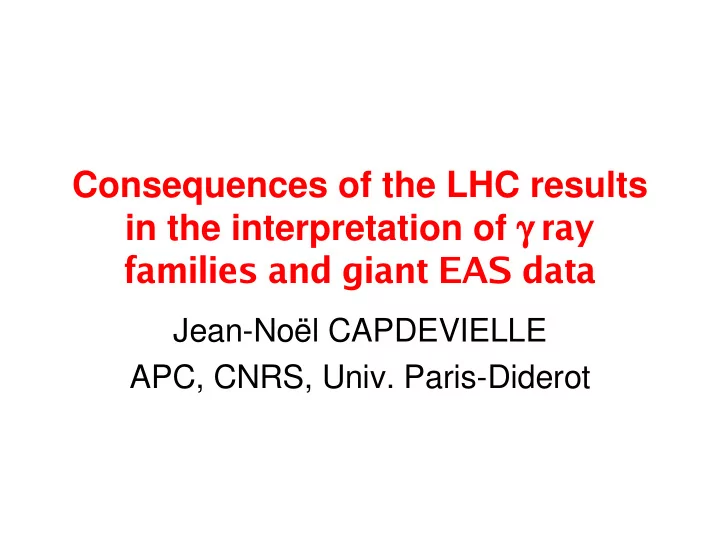

Consequences of the LHC results in the interpretation of γ ray families and giant EAS data Jean-Noël CAPDEVIELLE APC, CNRS, Univ. Paris-Diderot
Remarkable cosmic ray events in the LHC energy range • From X-emulsion Chambers • Exotics, fluctuation • Centauros ? artefacts or tracks • Coplanar emission to new physics ? • Spikes in pseudo • Phase transition to rapidity distribution QGP • Needs from EAS • Diquark breaking • Large multiplicities mechanism and large Pt’s • Fragmentation of • Rising energy cross strings with very sections high tension
CERN Courier april 97 Near 10 7 GeV, 211 γ ’s
JF2af2 and Strana 2 events with alignments in the stratosphere N γ E γ E th (TeV) (TeV) JF2af2 211 1586 0.2 Strana 76 1400 2. Strana from a russian balloon flight at 10g/cm2 30 Hadrons in Strana (2500 TeV) JF2af2 at 100g/cm2
String Model and di-quark breaking Valence quark 1 κ = ≅ Tension 1 GeV /fm ′ π α 2 ′ α : Regge Slope κ 〈 〉 = 2 p π T Valence diquark Schwinger theory, tension 10 times larger for partners of valence diquark? q q The pair is created when the distance L exceeds a threshold value. L Above a threshold energy, the di-quark is broken excluding recombination q 1 q q q q 2 3 of the leading cluster.
Most energetic gamma’s aligned in realtion with valence quarks? Very large tension for the diquark partners ? Energy threshold for valence diquark fragmentation √s = 4-5 TeV ? q 3 Maximal tension when the 3 valence quarks are at the largest distance from q each other, then 2 aligned. q 1 Minimal energy consumed at Diquark separation threshold and maximal probability of observation in cosmic rays
When E(cms) exceeds the threshold, the coplanar emission disappears, but non aligned clusters remain
CERN Courier October 1981 Experiences ECHOS started in October 1978 0ne collision of 10 6 GeV (high multiplicity, spikes in the distribution of pseudo-rapidité) at first exposure
Hints of hot spots for QGP ? Nucleus-Nucleus Collisions, 82
TADJIKISTAN No alignements in super families above 7 TeV in CMS
Violation du scaling de KNO (1000 collisions) 10 20 eV
Energy densities above 30 GeV/Fm3
Lateral distribution of γ ’s simulated for LHCf
New guidelines from LHC • CMS, ATLAS and ALICE • Central pseudo rapidity densities larger than expected in usual models ! • dN ch /d η = 4.47 ± 0.04(stat.) ±0.13(syst) √ for s= 2.36 TeV (2.97 PeV in Lab.) • dN ch /d η = 6.01 ± 0.01(stat.) -0.62 +0.2 (syst) √ for s= 7 TeV (26.1 PeV in Lab.) NSD
Guidelines inserted in Hybrid dual parton model • dN ch /d η = 0.595 s 0.13 for s > 0.9 TeV √ • dN ch /d η = 0.74 s 0.105 from UA5 data • N ch = 2.257 s 0.195 for s > 0.9 TeV √ • N ch = -7 + 7.2 s 0.127 from UA5 data • Landau Hydrodynamical model predicted a behaviour (assuming a major part of CMS available energy converted in s 0.25 whereas Feyman’s scaling and colliders were in favour of s 0.13
Alice 6.01 CMS 4.47 CMS 3.48
Fe or fat proton ? Change of p interaction near 2-3 EeV or progressive evolution of the collision with higher multiplicities and cross sections?
CONCLUSION • A situation similar to the period preceeding the discovery of the Charm. • Several simulations shows that coplanar events as well as spikes could result from random groupings • However spikes close to fragmentation region, as well as alignements concentrated near 3-5 TeV CMS energy could be investigated in LHC
CONCLUSION • The faster increase of central rapidity density (multiplication of chains in central region) suggests more muons in EAS, a maximum at higher altitude and lower primary mass in the knee region. • If those tendancies persists, the maximum depth at UHE observed in AUGER would be explain by a pure proton composition.
Recommend
More recommend